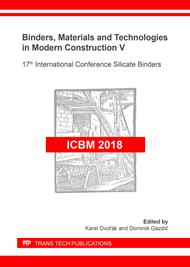p.3
p.9
p.15
p.21
p.27
p.35
p.41
p.47
Effect of Ratio of Liquid Pigment on Colouring Cement Matrix
Abstract:
Nowadays, the colouring is used in wide range of architectural concrete. Therefore, determination efficiency of pigments in case of particular combination of input materials is necessary. The research deals with influence of concentration of liquid inorganic pigments on the resulting colour of cement mortars. Two liquid pigments (yellow, red) were used for measurement purposes to verify their optimal ratio to achieve the best colouring of cement specimens. Pigments were mixed in the mortars of two types of cements used for architectural and decorative design. The colour change was determined using Konica Minolta spectrophotometer in colour space CIE Lab (1976). General definition of deviation in the colour space ΔELab was applied for calculating of colour deviation. From the results of the laboratory tests is obvious that significant change of the colour of cement specimens do not show between the concentration of 6% and 9% of the pigment per cement weight yet. Consequently, using of high ratio of pigment than 9% is not profitable neither for purchaser, nor builder. Future research will focus on trials with a more elaborate share of pigment and it will have importance for price optimization in the construction industry.
Info:
Periodical:
Pages:
3-8
Citation:
Online since:
August 2019
Authors:
Keywords:
Price:
Сopyright:
© 2019 Trans Tech Publications Ltd. All Rights Reserved
Share:
Citation:


